Devil is in the details

Reading lengths: 15min;
Method: Affinity Clustering;
Content: Experiance; Reflections
Complexity: Easy;
Keywords: #clustering; #grouping; #tendencies; #sets and
subsets; #characteristics; #categorization; #unique themes;
#games
The affinity clustering method or the task of ordering and reordering post-it notes might sound monotonous and boring. Something that is not very inspiring to do. Maybe, but only if you ignore all the creative potential within it. If you look at this activity as a technical task with a sole purpose – rearranging the post-it notes - I agree it will be pretty mundane. However, if you face this task with the prospect of discovering something new, it already feels more inspiring. It really can become as enjoyable as playing detectives. "Devil is in the details," they say, and this method proves the phrase.
"Affinity clustering" method – HOW does it work and WHAT value does it add
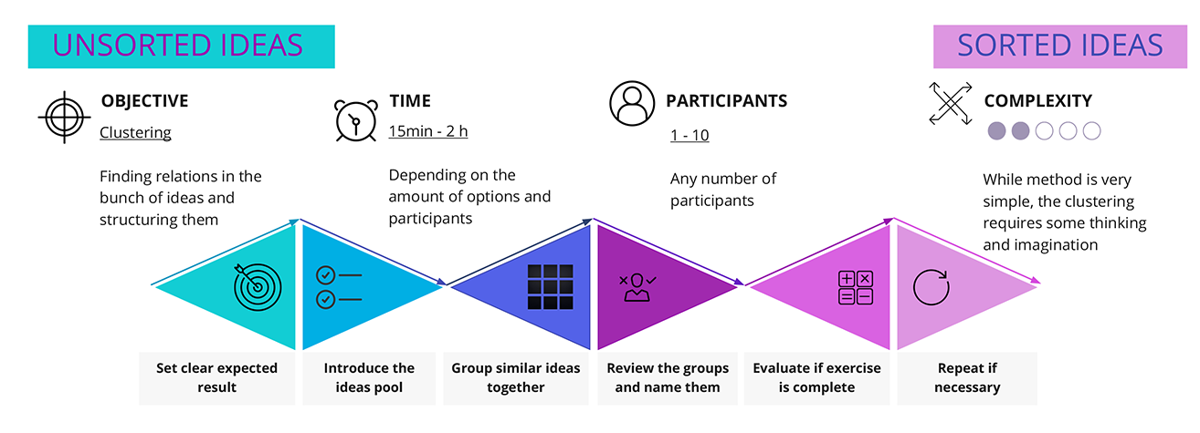
Reading lengths: 20min;
Method: Affinity Clustering;
Content: Method desription;
Complexity: Moderate;
Keywords: #clustering; #grouping; #similarities; #sets and subsets;
#characteristics; #actions; #ideas;
This article will describe one of the precious design thinking methods that is irreplaceable when there are plenty of ideas to work with. Affinity clustering or also called affinity mapping, grouping. In contrast to most design thinking methods oriented on opening new potential, affinity clustering is precisely the opposite – it is oriented towards narrowing the attention scope and replacing individual ideas with clusters of similar ideas. Such narrowing is essential in the creative process. Are you surprised why? Because while you and your team are in the discovery phase, you have the purpose of generating as many new ideas as possible. Yet when sessions end with hundreds of new ideas, that could become a problem too since choosing the focus point for the subsequent actions will become more problematic. What you can do, though, is to smartly group and cluster ideas and make the scope manageable again. Further in this article, I’ll write about how to do it.
Are creative problem solving methods a waste of time?

Reading lengths: 20min;
Method: Sailboat;
Content: Experience; Reflections
Keywords: #sailboat method; #to do or not to do;
#challanges; #oportunities; #the gains; #the time
This article will review creative problem solving and preparation from another angle – what might happen if you DON'T invest time and energy to analyze and plan ahead. Regardless of whether you are alone in pursuit of a happy ending or with the other people interested in achieving the goal.
I think that from this introduction it might be transparent where I'm going with this. Might it seem it does lead to the failure? Yes, of course, otherwise I wouldn't be writing this article. However, my key focus in this article is not on the failure itself. Failures do happen, and we (hopefully) learn from them, so they are inseparable from our development path. But what is more interesting is why a person who is native in planning, analyzing, structuring, and does know by heart the reasons to do it does herself skip these activities and afterward are surprised about the consequences. Why did I decide I didn't need analyzing and planning in the case I will be talking about? And what have I learned from it? Will I now plan every single step? Does the time investment pay off to plan every single step? I'll talk about that at the end of this article, but I'll start by describing the situation that led me to this.
When the challenges are the best that has happened?
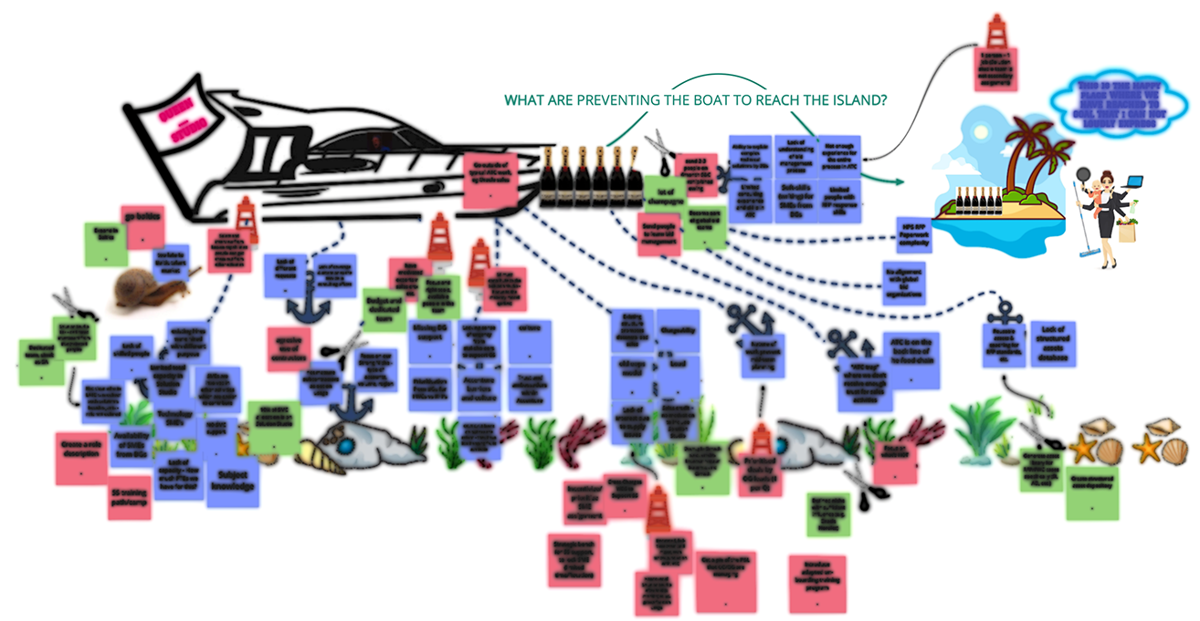
Reading lengths: 15min;
Method: Sailboat;
Content: Usage example; Profesional case
Complexity: Moderate
Keywords: #ideas generation; #known and unknown; #work and
fun; #team engagement; #solution ideas
Let's assume you have your personal goal or team goal that you
have been going after already for a while. There might be specific
achievements already, yet you are not really satisfied with the
achieved result. And it's somewhat hard to move forward. Something
is not happening as smoothly as expected. For something you might
have lost the trust, why is it needed after all. Sounds familiar? I
know these types of situations happens quite often since it occurs
to me as well. The first step towards changing something is to
acknowledge and admit – yes, this is happening right now. Only when
you have acknowledged it's happening, you have a chance to change
something. You could, of course, decide to stubbornly continue in
the same manner and try to pull the baggage with all the strengths
you can assemble. Or you could choose to help yourself by changing
something. You could stop to think and rethink, understand what you
need to change, and then continue the path with the enhanced
version of your baggage and strengths. This article will describe
how we used the sailboat method with my team in such a
situation.
Surprise yourself with ideas you didn’t yet know, you know
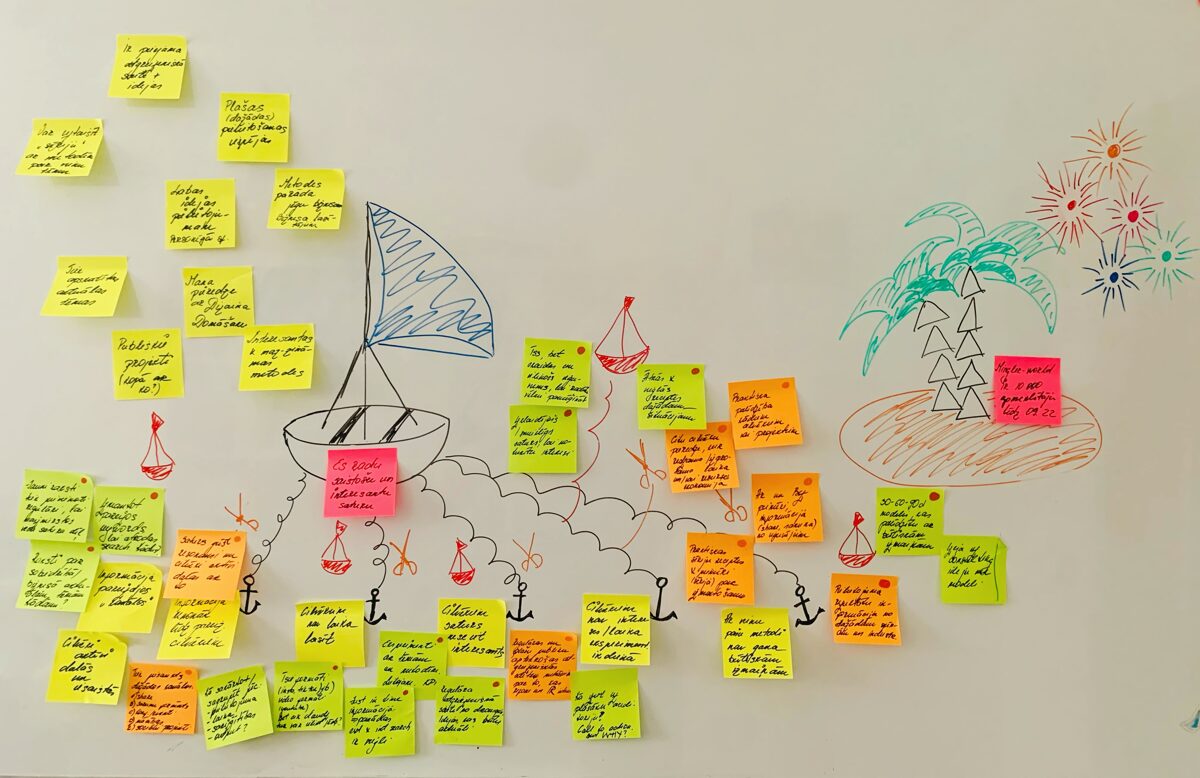
Reading lenghts: 15min;
Method: Sailboat;
Content: Usage example; Personal case
Complexity: Moderate;
Keywords: #planning; #structure; #ideation; #strong sides;
#risks and issues; #solutions; #kick-of activity; #personal
goals
In this article, I will describe how I used the sailboat method
to help myself plan the achievement of my goal. Whenever we start
something new, our thoughts often bounce from one question to
another. Should I do this, or maybe I could do that. All of these
ideas are without any doubt good and worth to be written down. Yet,
even if I see all of them in front of me written on A4 paper, it
doesn't mean this list gives me a holistic picture of the situation
and all essential factors impacting it. To gain such a view, I can
use methods like the sailboat. The sailboat method will help
structure known and hint at the areas still to think about.
"SAILBOAT" method – HOW does it work and WHAT value does it add
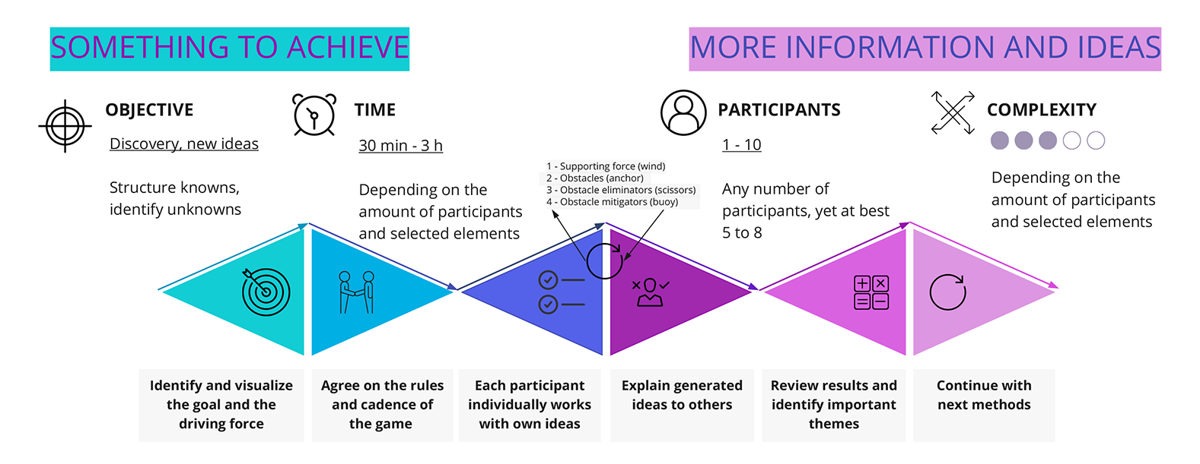
Reading: 20min;
Method: Sailboat;
Content: Method desription;
Complexity: Moderate;
Atslēgvārdi: #structure; #flexibility; #game; #analysis;
#ideas generation; #focus on strenghts; #risks and issues; #problem
solving; #template in Miro tool
The sailboat method is an excellent method to use whenever you
start something new or need a refresh. The method provides an easy
framework to analyze and summarize different important factors
regards the target to be achieved or the problem to be solved. Yet,
since the method is quite flexible, it can be used in many
different ways. Further, in the article, I'll talk more about
specific details.
Hidden gem of socials networks

Reading time: 15min;
Method: Dot voting;
Content: Usage example; Personal case
Complexity: Easy;
Keywords social networks; #research; #people opinion;
#another form of voting
The usage of the dot voting method in groups of multiple people is clear and straightforward. Yet what if you don't have a group of people in front of you, but you still are interested in other people's opinions about a specific question? You could take the phone and start calling your friends to ask what they think and get into discussions with them. Or you could try different approaches. In this article, I'll describe how to utilize always present social networks to gather more insights on questions interesting to you.
When arguments don't work, the game might

Reading time: 10min;
Method: Dot Voting;
Content: Usage example; Personal case
Complexity: Very easy;
Keywords :#game; #no arguing; #getting to the
results;#playing games with children; #fun and energy
There are battles where it is worth getting involved in and win.
But then there are also battles where it's much wiser not to get
involved. It is when you gain more by staying in an observer role.
While there are so many situations like this around us, in this
article, I'll give an example of a mundane family case where the
dot voting game gave my family and me more benefits than getting
into disagreements. I think this article could be especially
intriguing for mothers interested in practical methods to outplay
children's stubbornness.
"DOT VOTING" method - HOW does it work and WHAT value does it add
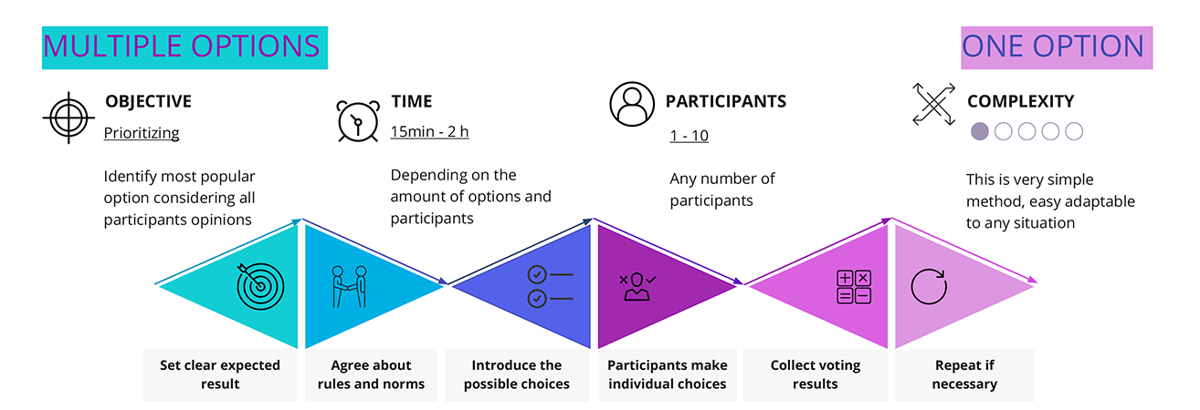
Reading: 15min;
Method: Dot Voting;
Content: Method description;
Complexity: Very easy;
Keywords: #individual vs group opinion; #prioritization;
#understanding; #insights; #usage examples
In this article, I will describe one of the basic design
thinking methods – Dot Voting. I will start with an explanation of
why the dot voting method is so important and widely used. I expect
it could be more interesting for those of my readers to whom design
thinking is still a new area. After that, I'll describe in more
detail how to use this method. I will give a short description and
key attention points of each step. And I'll finish by giving some
examples where the method can be used in a wide range of
situations, including outside the professional field and design
thinking framework.